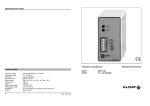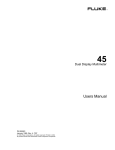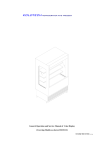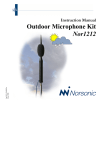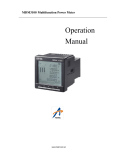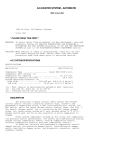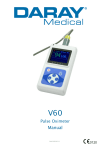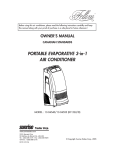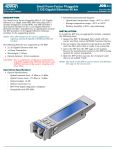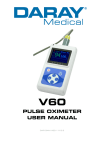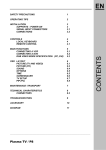Download Operating Instructions Cleaning Disposal Technical Data
Transcript
Operating Instructions 1.3 as long as loop B is occupied. Not until loop B has been completely vacated, does the output signal decline again. AB PRESENCE MODE Loop A B RLY A RLY B The same principle applies correspondingly on driving onto the loops from the other direction. no no yes no yes no no no In the "AB PRESENCE MODE" a directiondependent signal is issued which can be used if the presence of a vehicle on loop B is to be signalled. Cases for application can be, for example, parking barriers or gates with an automatic timer function which should not be allowed to close until a vehicle has completely left the closing area (loop B). Principle: If a movement from loop A to loop B takes place, then only output A in accordance with the diagram is switched. After loop A has been activated, output A remains switched The relay output jumpers PP1and PP2 cannot be adjusted in this operating mode but are permanently switched to continuous operation (PRESENCE). Cleaning • • Carefully wipe down the casing with a damp, lint-free cloth. Do not use any cleaning agents containing solvents. These pose a health risk and can damage the casing surface. Disposal Waste electrical products and batteries may not be disposed of with household waste! Dispose of the waste product via a collection point for electronic scrap or via your specialist dealer. Put the packaging material into a container for cardboard and paper. Induction Loop Detector Technical Data Frequency range Inductance range Sensitivity Response time Power supply Current input Output Max. contact rating Temperature range Dimensions Weight 7 ILD21 ILD22 4-stage adjustable: 20 – 140 kHz 20 – 1.500 µH 4-stage adjustable approx. 120 ms 230 V AC ± 15 %; 12-24 V AC / DC ± 15 % 165 mA 2 relays 5 A / 230 V AC -40 °C to +80 °C 75 x 40 x 76 (90 incl. connector) mm (H x W x D) approx. 220 g 69178 0608 GB 230 V AC 12 - 24 V AC/DC Operating Instructions Operating Instructions Fig. 1 (unit front) Operating Instructions Fig. 2 (PCB, inside) Important: To adjust the jumpers, remove the casing cover. Any adjustments must always be made in the de-energized state. In the continuous operating mode (PRESENCE), the output remains switched as long as a vehicle is located within the loop's range of action. With pulse operation (PULSE) the output relay switches for approx. 0.8 s once the loop has responded. 1. 1.2 AB Logic Direction Detector Jumper AB (see fig. 2) AB PULSE MODE Loop A *ex factory state 1.1 Fig. 3 (Connection scheme, see also side of casing) AB OFF Loop A B RLY A RLY B yes no yes no no yes In the "AB OFF" mode both loops are operated independent of each other. In the "AB OFF" mode, the relay output of each loop (jumper PP1 or PP2) can be set for either pulse operation (PULSE) or continuous operation (PRESENCE): B RLY A RLY B no no no no yes (pulse) no In the "AB PULSE MODE“ a directiondependent signal is issued which can be used if the departure of a vehicle from the triggering loop is to be signalled. Cases for application can be, for example, parking barriers or gates which should not receive a command to close until a vehicle has completely left the closing area (loop A). Principle: If a movement from loop A to loop B takes place, then only output A in accordance with the diagram is switched. Output A generates a pulse if on vacating loop A, loop B is still occupied. The same principle applies correspondingly when the loops are driven onto from the other direction. The relay output jumpers PP1and PP2 cannot be adjusted in this operating mode but are permanently switched to pulse operation (PULSE). *ex factory state CONNECT THE CORRECT SUPPLY VOLTAGE ! ILD21 CONNECTIONS 1, 2 (N, L) 230 V AC, ILD22 CONNECTIONS 1, 2 (N, L) 12 - 24 V AC/DC 1 69178 0608 GB 69178 0608 GB 6 Operating Instructions SENS Setting the Sensitivity The sensitivity can be set for various vehicle types: The settings "MED-HIGH" or "MED-LOW" are optimized for the majority of applications. For vehicles with minimal metal mass (e.g. bicycles), the sensitivity can be set at HIGH. Operating Instructions Switch 7: ASB Example: signal sequence for long truck combinations with and without ASB: Loop A or B Description of Function ILD Induction Loop Detector, Operating Instructions Together with the wire loops laid in the ground, the induction loop detectors are designed for detecting vehicles (metal masses) and triggering an action. Accessories: Connecting base "ILD-RELBASE“ Signal Switches 3, 4: sensitivity channel 1 Switches 5, 6: sensitivity channel 2 Supply package, Accessories no Safety Advice • yes • yes (with ASB) no (without ASB) yes no Change in inductance ∆L/L in the case of various vehicle types (loop 2m x 1m, 3 windings): Bicycle 0.02% Motorcycle 0.12% Truck 0.4% Car >1.0% ASB Automatic Sensitivity Boost If the ASB is switched on, when a vehicle is detected the sensitivity of the detector is automatically increased to the maximum. In this way long truck combinations and vehicles with high-set chassis can be reliably identified and premature closing, e.g. of a barrier, prevented. 5 Switch 8: PRES Electrical installation and programming may only be carried out by a qualified electrician! • Have faulty units checked by the manufacturer! • Do not make any unauthorized alterations or modifications to the unit! PRES Signal Holding Time The signal holding time can be set via switch 8 for either PERMANENT PRESENCE or LIMITED PRESENCE. Before connecting and putting the unit into operation, carefully read through the Operating Instructions. Designated Use • They can be used for controlling parking lot barriers, warehouse rolling shutters, garage doors or also for detecting vehicles in front of automatic traffic lights. The 2-channel models can also detect the direction in which vehicles are travelling. Special Features: • Automatic self-adjustment on the loop connected as well as after altering the unit's settings. This guarantees that the unit is easy to put into service and to operate. • Maintenance-free thanks to automatic compensation of atmospheric and environmental influences. • Adjustable sensitivity and automatic sensitivity boost to reliably identify various vehicle types. • Output via floating relay contacts with a max. contact rating of 5 A / 230 V AC. • Indication of operating state and malfunctions via LEDs. The unit may only be used as a decoder device for induction loops! Unpacking At the "PERMANENT PRESENCE" setting, the detector will constantly compensate for all atmospheric and environmental influences as long as a vehicle occupies the loop. At the "LIMITED PRESENCE" setting, the detector will constantly compensate for all atmospheric and environmental influences for the duration of approx. 45 minutes, after which the output is automatically reset. 69178 0608 GB Unpack the items supplied. Check that the delivery is complete! Dispose of the packaging in the designated collection containers for the recycling of cardboard, paper and plastic. 69178 0608 GB 2 Operating Instructions Operating Instructions Functional Restrictions • "Cross-talk" If the loops of two detectors are located directly next to each other, then the magnetic fields can overlap and cause interference, resulting in malfunctions. This can be avoided by taking the following measures: • • • • Set different working frequencies on the detectors. The closer the loops are to each other, the greater the difference in frequency should be. Increase the distance between the two loops ( > 2 meters recommended). If the feeder cable is laid next to other electric cables, it should be shielded. This shielding only needs to be earthed on the detector side. The feeder cable must be twisted with approx. 20 turns per meter. The sensitivity of the loop reduces, the longer the feeder cable is. The feeder cable should therefore be as short as possible and not exceed 100 meters in length. • "Feeder cable and loop cable" • The feeder cable and loop cable should be of the same material. Junction points between the loop and feeder cable should be avoided. • The cable must be of the insulated wire 2 type with a cross-section of >1.5 mm (recommended: loop cable type SIAF 1.5 mm²). 3 Make sure that the induction loops are not occupied while self-adjustment is taking place since also the sensitivity of the loop is redetermined during this process. FREQ Setting the Frequency Putting into Operation Connect the induction loops, the relay outputs and the supply voltage. Please note: ILD21 connections 1, 2 230 V AC ILD22 connections 1, 2 12 - 24 V AC/DC "Detector" • Attach the detector in a suitable weatherprotected location. Given the size of loop stated below, the following number of windings are required: Size of loop 3- 6m 6 - 10 m 10 - 30 m • Number of windings 4 3 2 Place the loops in the grooves which must be cut into the road surface (fig. 5). To accommodate the feeder cable, a groove should be run from one corner of the loop to the corner of the road. Nominal groove width: Nominal groove depth: Important: Each time the settings on the unit have been altered, the RESET button must be pressed! The unit then automatically performs a selfadjustment! Fig. 4 • Settings and Adjustments Fig. 5 The length of the loop is determined by the width of the road to be monitored. It should extend up to 300 mm from each edge of the road (fig. 4). Add two more windings to the loop. Select the maximum distance possible between the steel reinforcement and the loop cable. Installation Instructions • The loop corners should be set at an angle of 45° in order to avoid damaging the cable (fig. 4). Twist the feeder cable to the detector (> 20 turns per meter). Installing the Induction Loop "Reinforcements" Steel reinforcements under the road can adversely affect the performance of the loop detection system. This interference can be reduced by taking the following measures: • • • 4 mm 30 – 50 mm 69178 0608 GB After being switched on for the first time, as well as following a power failure or after every RESET, the detector automatically performs a self-adjustment (depending on the set frequency "FREQ", the LED’s CH1 and CH2 flash 4 to 7 times). After the automatic self-adjustment has been completed, the ON LED lights up. The unit is now ready for operation. If, for example, two detectors are installed, the risk of cross-talk beween adjacent induction loops can be avoided by setting different working frequencies on the detectors (see also "cross-talk" in the section "Functional Restrictions"). Switches 1, 2: setting the frequency HIGH approx. 140 kHz MED HIGH approx. 100 kHz MED LOW approx. 60 kHz LOW approx. 20 kHz Operating Mode Indicator ON CH1 CH2 The ON LED indicates that the detector is ready for operation Glowing constantly: loop A occupied Flashing: loop malfunction Glowing constantly: loop B occupied Flashing: loop malfunction 69178 0608 GB 4




